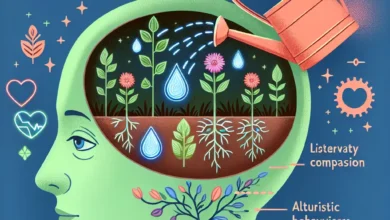Puzzle Pieces of Perspective: Fitting Together the Empathy Jigsaw

Introduction: Unlocking the Power of Empathy
Have you ever felt truly understood by someone? That warm, comforting feeling is the magic of empathy at work. In today’s fast-paced world, empathy is like a hidden superpower that can transform our relationships and improve our overall well-being.
Welcome to our exploration of the “Puzzle Pieces of Perspective: Fitting Together the Empathy Jigsaw.” In this post, we’ll break down the complex concept of empathy into manageable pieces. Our goal? To help you understand and develop this crucial skill, piece by piece.
What is Empathy?
At its core, empathy is the ability to understand and share the feelings of another person. It’s like having an emotional radar that picks up on others’ experiences. But empathy isn’t just one thing – it’s a combination of different skills and abilities.
There are three main types of empathy:
- Cognitive empathy: Understanding someone’s thoughts and feelings
- Emotional empathy: Actually feeling what someone else is feeling
- Compassionate empathy: Understanding, feeling, and taking action to help
Empathy plays a crucial role in both personal and professional relationships. It helps us connect with others, resolve conflicts, and create a more harmonious world around us.
The Puzzle Pieces of Empathy

1. Self-Awareness: The Foundation
Self-awareness is the cornerstone of empathy. It’s about understanding your own emotions, thoughts, and reactions. When you’re in tune with yourself, you’re better equipped to understand others.
Here are some tips to boost your self-awareness:
- Keep a daily emotion journal
- Practice mindfulness meditation
- Ask for feedback from trusted friends or family
- Reflect on your reactions to different situations
By developing self-awareness, you’re laying the groundwork for stronger empathy skills.
2. Active Listening: Tuning In to Others
Active listening is a powerful tool for building empathy. It’s not just about hearing words – it’s about fully focusing on and understanding the speaker.
Try these techniques to improve your active listening:
- Give your full attention to the speaker
- Use non-verbal cues to show you’re engaged (nodding, maintaining eye contact)
- Ask clarifying questions
- Paraphrase what you’ve heard to ensure understanding
- Avoid interrupting or jumping to conclusions
When you listen actively, you create a safe space for others to express themselves, fostering deeper connections and understanding.

3. Perspective-Taking: Walking in Another’s Shoes
Perspective-taking is the ability to see situations from different angles. It’s like being able to step into someone else’s mind and understand their point of view. This skill is crucial for developing empathy and resolving conflicts.
Here are some exercises to practice perspective-taking:
- Read books or watch movies from different cultures
- Engage in role-playing exercises
- Volunteer for organizations that serve diverse populations
- Travel to new places and immerse yourself in local customs
- Seek out conversations with people who have different backgrounds or beliefs
By regularly practicing perspective-taking, you’ll broaden your empathy horizons and become more understanding of others’ experiences.
4. Emotional Intelligence: The Heart of Empathy
Emotional intelligence (EI) is closely linked to empathy development. It involves recognizing, understanding, and managing emotions – both your own and others’.
Here’s a simple table breaking down the components of emotional intelligence:
| Component | Description |
|---|---|
| Self-awareness | Recognizing your own emotions |
| Self-regulation | Managing your emotions effectively |
| Motivation | Using emotions to achieve goals |
| Empathy | Understanding others’ emotions |
| Social skills | Managing relationships and communication |
Developing your emotional intelligence skills can significantly enhance your ability to empathize with others. It’s like upgrading your emotional operating system, allowing you to process and respond to emotions more effectively.

5. Non-Verbal Communication: Reading Between the Lines
A large part of human communication is non-verbal. Being able to read and understand body language is crucial for empathy. Here are some common non-verbal cues to look out for:
- Facial expressions (smiles, frowns, raised eyebrows)
- Body posture (open or closed, leaning in or away)
- Gestures (hand movements, nodding, shrugging)
- Eye contact (maintained, avoided, or excessive)
- Tone of voice (pitch, volume, speed)
By paying attention to these cues, you can gain valuable insights into someone’s emotional state, even when their words might not tell the whole story.
6. Cultural Sensitivity: Bridging Differences
In our diverse world, cultural sensitivity is a vital piece of the empathy puzzle. Different cultures express and perceive emotions in various ways. Developing cultural empathy helps us navigate these differences with respect and understanding.
Here are some tips for developing cultural empathy:
- Learn about different cultures through books, documentaries, or cultural events
- Practice suspending judgment when encountering unfamiliar customs
- Ask respectful questions to gain understanding
- Recognize and challenge your own cultural biases
- Seek out diverse friendships and relationships
Remember, cultural misunderstandings can happen, but they’re also opportunities for growth. For example, in some cultures, direct eye contact is a sign of respect, while in others, it might be considered rude. By approaching these differences with curiosity and openness, we can build bridges of understanding.
Putting the Empathy Puzzle Together
Now that we’ve explored the individual pieces, let’s see how they fit together to form a complete picture of empathy. Remember, developing empathy is an ongoing process – it’s not about perfection, but continuous growth and practice.
Here are some practical exercises to combine different aspects of empathy:
- The Empathy Mirror: Practice mirroring someone’s body language while actively listening to them. This combines non-verbal awareness with active listening.
- Cultural Perspective Journal: Write about a recent interaction from the perspective of someone from a different culture. This blends perspective-taking with cultural sensitivity.
- Emotion Detective: Try to identify the emotions behind someone’s words and actions, using your emotional intelligence and non-verbal communication skills.
- Empathy Meditation: During meditation, focus on sending compassionate thoughts to others, combining self-awareness with emotional empathy.
Benefits of Mastering the Empathy Jigsaw
Developing your empathy skills can lead to numerous benefits:
- Improved relationships: Empathy helps you connect more deeply with others, leading to stronger, more meaningful relationships.
- Better communication skills: Understanding others’ perspectives enhances your ability to communicate effectively.
- Enhanced leadership abilities: Empathetic leaders are often more successful in motivating and inspiring their teams.
- Increased emotional well-being: Empathy can reduce stress and increase overall life satisfaction.
Challenges in Developing Empathy
While the benefits are significant, developing empathy isn’t always easy. Here are some common challenges and strategies to overcome them:
- Overcoming biases: We all have unconscious biases. Recognize them and actively work to challenge them.
- Managing emotional overwhelm: Sometimes, feeling others’ emotions can be intense. Practice self-care and set healthy boundaries.
- Dealing with different perspectives: It can be challenging to empathize with views very different from your own. Stay curious and open-minded.
- Maintaining empathy in stressful situations: Stress can make it harder to empathize. Use mindfulness techniques to stay grounded.
Remember, patience and practice are key. Empathy is a skill that develops over time, so be kind to yourself as you learn and grow.
Conclusion
As we wrap up our journey through the empathy jigsaw, remember that each piece plays a crucial role in creating a fuller, more compassionate understanding of others. By developing self-awareness, practicing active listening, taking different perspectives, honing your emotional intelligence, reading non-verbal cues, and embracing cultural sensitivity, you’re well on your way to becoming an empathy expert.
Starting your empathy journey might seem daunting, but the rewards are immeasurable. Every small step you take towards understanding others better is a step towards a more connected, harmonious world.
So, are you ready to start putting your empathy puzzle together? Remember, every interaction is an opportunity to practice and grow. Embrace the challenge, celebrate your progress, and watch as your relationships and well-being transform through the power of empathy.
Taking Action: Your Empathy Development Plan
Now that you understand the pieces of the empathy puzzle, it’s time to put this knowledge into action. Here’s a simple plan to help you start your empathy journey today:
- Set an empathy goal: Choose one aspect of empathy you want to focus on this week. For example, “I will practice active listening in three conversations.”
- Daily reflection: Spend 5 minutes each evening reflecting on your empathy experiences. What went well? What could you improve?
- Empathy challenge: Try to see a situation from someone else’s perspective at least once a day. It could be a news story, a friend’s problem, or a family disagreement.
- Emotion vocabulary: Learn one new word for an emotion each day. This will help you better identify and express feelings.
- Cultural exploration: Once a week, learn about a different culture’s customs or traditions. This will broaden your perspective and increase cultural sensitivity.
Remember, developing empathy is a lifelong journey. Be patient with yourself and celebrate small victories along the way.

Final Thoughts: The Ripple Effect of Empathy
As you develop your empathy skills, you’ll likely notice positive changes not just in your relationships, but in your community as well. Empathy has a ripple effect – when you show understanding and compassion, it inspires others to do the same.
Imagine a world where everyone took the time to truly understand each other. Conflicts would decrease, cooperation would increase, and we’d all feel more connected and supported. By working on your empathy skills, you’re contributing to this vision of a more compassionate world.
Your Turn to Share
We’d love to hear about your experiences with empathy. Have you had a moment where empathy made a significant difference in your life? Or perhaps you have a tip for developing empathy that we haven’t mentioned?
Share your thoughts in the comments below. Your insights could be the missing piece in someone else’s empathy puzzle!
Thank you for joining us on this exploration of empathy. Remember, every step you take towards understanding others is a step towards a happier, more connected you. Keep practicing, stay curious, and watch as your empathy skills transform your world, one interaction at a time.



